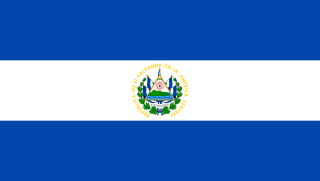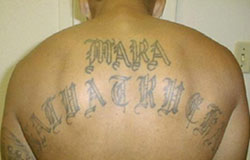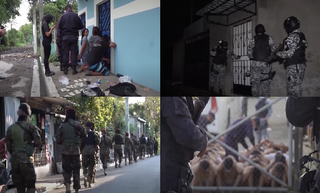
El Salvador, officially the Republic of El Salvador, is a country in Central America. It is bordered on the northeast by Honduras, on the northwest by Guatemala, and on the south by the Pacific Ocean. El Salvador's capital and largest city is San Salvador. The country's population in 2024 was estimated to be 6 million according to a government census.
Politics of Guatemala takes place in a framework of a presidential representative democratic republic, where by the President of Guatemala is both head of state, head of government, and of a multi-party system. Executive power is exercised by the government. Legislative power is vested in both the government and the Congress of the Republic. The judiciary is independent of the executive and the legislature. Guatemala is a Constitutional Republic.

Politics of Honduras takes place in a framework of a multi-party system presidential representative democratic republic. The President of Honduras is both head of state and head of government. Executive power is exercised by the government. Legislative power is vested in the National Congress of Honduras. The party system is dominated by the conservative National Party of Honduras, the Liberal Party of Honduras, and Liberty and Refoundation.

San Pedro Sula is the capital of Cortés Department, Honduras. It is located in the northwest corner of the country in the Sula Valley, about 50 kilometers south of Puerto Cortés on the Caribbean Sea. With a population of 701,200 in the central urban area and a population of 1,445,598 in its metropolitan area in 2023, it is the nation's primary industrial center and second largest city after the capital Tegucigalpa, and the largest city in Central America that is not a capital city.
The Sombra Negra, also known as El Clan de Planta, are death squad groups based in El Salvador, allegedly composed mostly of police and military personnel, that target criminals and gang members for vigilante justice. The name first appeared around December 1989 in the Department of San Miguel. By April 1995, the group had stated that it had killed seventeen persons, claiming that those killed were criminals or members of gangs. These vigilante groups are based in El Salvador. The government of El Salvador insists the groups are not under its control.
A mara is a form of gang originating in the United States, which spread to Central American countries such as El Salvador, Honduras and Guatemala.

Approximately 1.4 million people in the United States were part of gangs as of 2011, and more than 33,000 gangs were active in the country. These include national street gangs, local street gangs, prison gangs, outlaw motorcycle clubs, and ethnic and organized crime gangs.

Crime and violence affect the lives of millions of people in Latin America. Some consider social inequality to be a major contributing factor to levels of violence in Latin America, where the state fails to prevent crime and organized crime takes over State control in areas where the State is unable to assist the society such as in impoverished communities. In the years following the transitions from authoritarianism to democracy, crime and violence have become major problems in Latin America. The region experienced more than 2.5 million murders between 2000 and 2017. Several studies indicated the existence of an epidemic in the region; the Pan American Health Organization called violence in Latin America "the social pandemic of the 20th century." Apart from the direct human cost, the rise in crime and violence has imposed significant social costs and has made much more difficult the processes of economic and social development, democratic consolidation and regional integration in the Americas.

Mara Salvatrucha, commonly known as MS-13, is an international criminal gang that originated in Los Angeles, California, in the 1980s. Originally, the gang was set up to protect Salvadoran immigrants from other gangs in the Los Angeles area. Over time, the gang grew into a more traditional criminal organization. MS-13 has a longtime rivalry with the 18th Street gang.
Crime in Honduras has become a growing matter of concern for the Honduran population in recent years. Honduras has experienced alarmingly high levels of violence and criminal activity, with homicide rates reaching a peak in 2012, averaging 20 homicides per day. Corruption, extortion, coercion, and drug smuggling also run rampant throughout Honduran society, preventing the nation from building trustworthy authorities like police, and severely limiting economic, social, or political progress. The situation has prompted international organizations and governments to offer assistance in combating crime in Honduras.
Rates of crime in Guatemala are very high. An average of 101 murders per week were reported in 2018. The countries with the highest crime and violence rates in Central America are El Salvador and Honduras. In the 1990s Guatemala had four cities feature in Latin America's top ten cities by murder rate: Escuintla, Izabal (127), Santa Rosa Cuilapa (111) and Guatemala City (101). According to New Yorker magazine, in 2009, "fewer civilians were reported killed in the war zone of Iraq than were shot, stabbed, or beaten to death in Guatemala," and 97% of homicides "remain unsolved." Much of the violent nature of Guatemalan society stems back to a 36-year-long civil war However, not only has violence maintained its presence in the post-war context of the country following the Guatemalan Civil War, but it has extended to broader social and economic forms of violence.

Crime in El Salvador has been historically extremely high due to the presence of various gangs. As of 2011, there were an estimated 25,000 gang members at large in El Salvador; with another 43,500 in prison. The best-known gangs, called maras in colloquial Salvadoran Spanish, are Mara Salvatrucha (MS-13) and their rivals 18th Street; maras are hunted by death squads, including Sombra Negra. Newer rivals include the rising mara, The Rebels 13. El Salvador is one of the three countries of the Northern Triangle of Central America, along with neighboring Guatemala and Honduras, which are all afflicted with high levels of violence.

The nations of El Salvador and Mexico established diplomatic relations in 1838. Both nations are members of the Association of Caribbean States, Community of Latin American and Caribbean States, Organization of American States, Organization of Ibero-American States and the United Nations.

Salvadorans are the second largest Hispanic group in the United States and the second largest foreign born group in Los Angeles. The main wave of immigrants came during the Salvadoran Civil War in the 1980s, in order to escape the violence and political and economic instability in the country. Since then, Salvadorans have continued to migrate to Los Angeles as well as other cities around the United States. The community is well established in Los Angeles and stands as an integral part of its cultural and economic life.
Transnational gangs can be described as gangs that are located in multiple countries. When these gangs commit crimes in one country, their plans for the crime can sometimes be put together in another country. These gangs or mara are able to move around efficiently from one place to another. Transnational gangs are not a normal street gang because they are much larger in size and located in more than one country; they are considered to be able to pose a significant threat for the safety of the countries they are located in.

The Northern Triangle of Central America (NTCA) is a term used in the United States to refer collectively to the three Central American countries of Guatemala, Honduras, and El Salvador. The term is used with respect to the countries' economic integration, and their shared challenges, including widespread poverty, violence, and corruption, which have prompted many to become refugees fleeing the three nations.

The Salvadoran gang crackdown, known in El Salvador as the State of Exception or the War Against the Gangs, began on 27 March 2022 in response to a series of homicides committed by criminal gangs between 25 and 27 March 2022 which killed 87 people. After the killings, the Salvadoran government declared a state of emergency that suspended several constitutional rights and enabled the government to launch mass arrests of suspected gang members. The crackdown and state of emergency have since been extended 34 times as of 5 January 2025.

The Terrorism Confinement Center is a maximum security prison located in Tecoluca, El Salvador. The prison was built in late 2022 amidst a large-scale gang crackdown in El Salvador and was opened by the Salvadoran government in January 2023.

The blockade of the Cabañas Department was a military operation in El Salvador during the Salvadoran gang crackdown which started on 1 August 2023, when Salvadoran President Nayib Bukele announced that 7,000 soldiers of the Armed Forces of El Salvador (FAES) and 1,000 police officers of the National Civil Police (PNC) had surrounded the department of Cabañas to capture gang members.

The Mejicanos massacre, also known as the Route 47 massacre, occurred on 20 June 2010 when members of the 18th Street gang attacked two minibuses in the Salvadoran city of Mejicanos, just northeast of the capital city of San Salvador. During the massacre, members of Barrio 18 shot at one minibus and burned a second, killing 19 people in total and injuring 14 or 15 more.













